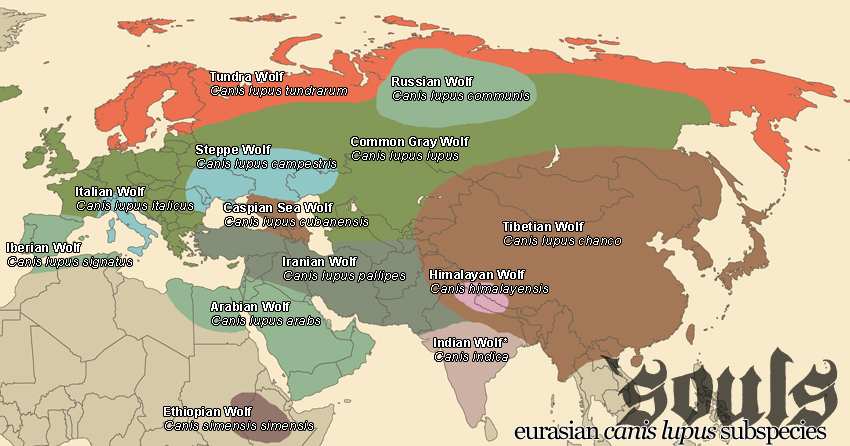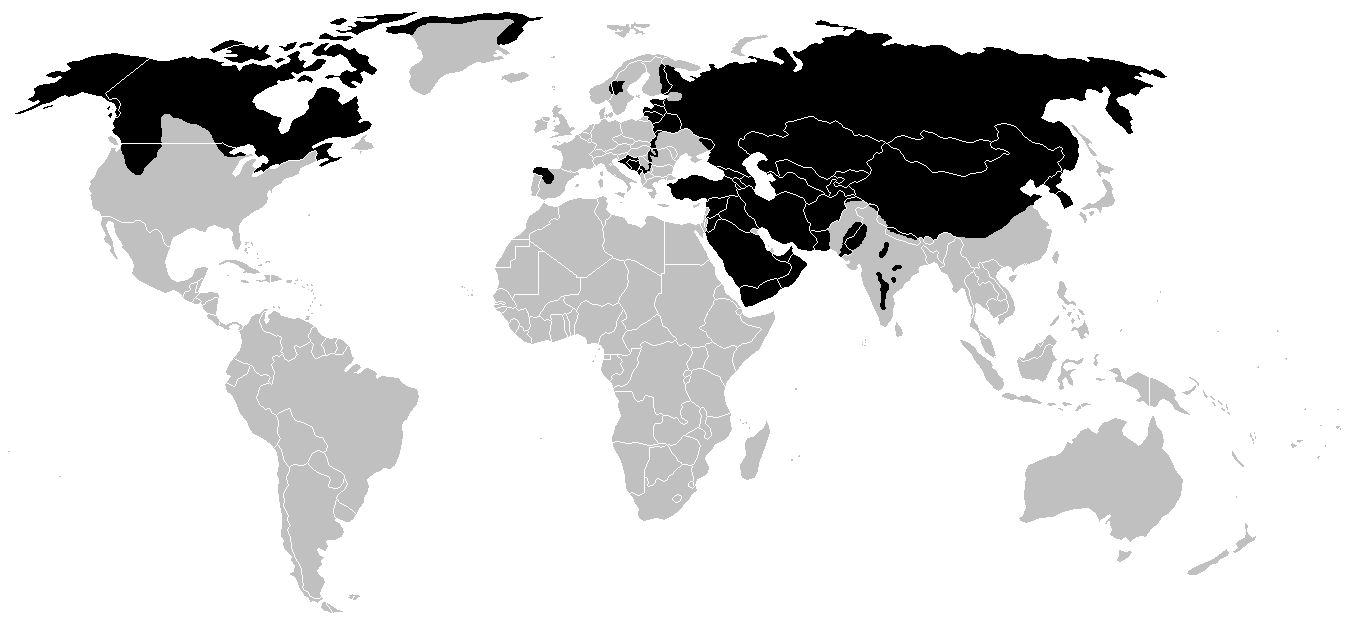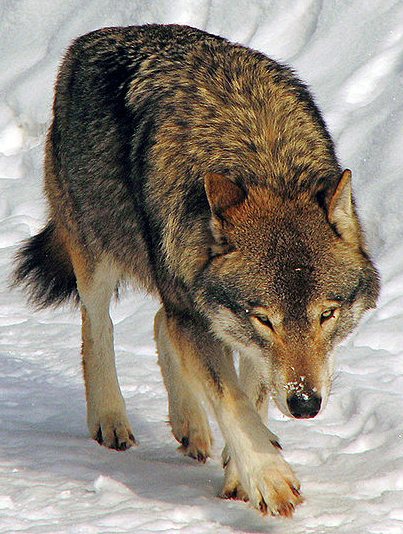Common Gray Wolf (''Canis lupus lupus'')
See our RP Guide for more extensive information regarding wolves.
On this page... (hide)
- 1. Common Names
- 2. Range
- 3. Appearance
- 3.1 Size
- 3.2 Coat and Coloration
- 4. Other Characteristics
- 4.1 Social Structure
- 4.2 Reproduction
- 4.3 Habitat
- 4.4 Diet
- 4.5 Survival
- 4.6 Luperci
- 5. Citations
1. Common Names
Eurasian Wolf, Common Grey Wolf, Eurasian Grey Wolf, Forest Wolf, Common Wolf
2. Range
Vast parts of Russia and Europe. Though the gray wolf was eradicated from most of western Europe and most of their southern range prior to the extermination of humanity, they have reclaimed much of their old territory since 1988.
Pre-human extinction range of gray wolves. From Eribo
3. Appearance
3.1 Size
Eurasian wolves and North American wolves are often compared: Eurasian wolves have longer and larger ears that are placed higher up on their heads. Their skulls tend to be narrower than their North American cousins, along with their loins. In general, northern wolves are larger than southern wolves—the higher the latitude and the colder the temperatures in which a canine lives, the larger it will be. Males tend to be larger than females by about 20%.
Eurasian wolves vary slightly in size and build according to their geographical region; Russian and Scandinavian wolves are larger and bulkier than those in Western Europe, and between Russian and Scandinavian wolves, the latter tend to be “more heavily built with deeper shoulders.“ Adult wolves in Russia weigh 70-110 lbs (32-50kg), and grow to 31.5 - 33.5 inches (80 - 85 cm) long. One of the largest wolves recorded was captured in Ukraine; the adult male weighed 190 lbs (86 kg).
Scandinavian Canis lupus lupus, photographed in Sweden. From Daniel Mott@Flickr
The paws of the gray wolf are specially adapted for survival: not only are they slightly webbed to allow for easier movement over snow, they also have special blood vessels in their paw pads and toes that keep them from freezing. In addition to this, “scent glands located between a wolf's toes leave trace chemical markers behind, helping the wolf to effectively navigate over large expanses while concurrently keeping others informed of its whereabouts.” Gray wolves also have a comparatively lower amount of sweat glands in their toes than other types of canines (e.g., coyotes or jackals).
3.2 Coat and Coloration
Wolves coats are multi-layered; the first consists of guard hairs that protect the undercoat from water and dirt. The second layer is a “dense, water-resistant undercoat that insulates.” This second layer is generally gray regardless of the coloration in the upper layers of fur. Wolves shed their undercoats between spring and summer—their coats are quite distinctive from winter to summer, and a wolf that may be especially dark and clearly-marked in winter may become very light in the summer. “Females tend to keep their winter coats further into the spring than males.”
In general, the fur coloration and texture is also different—more browns and tawny colors are seen in Eurasian wolves, and their coat tends to be coarser, with “less soft wool intermixed with it.” Many Eurasian wolves tend to have a dark stripe running along their spine; winter fur tends to be brighter in color than the duller summer fur. In the winter, the Eurasian wolf loses some of its tawny coloration. Wolves in southern Europe are generally “more richly colored” than northern counterparts. Black and white wolves are rare in this subspecies, although they do occur.
Fur coloration may or may not coincide with environment—although white wolves may be more common in areas with constant snow cover, “some scientists have concluded that the blended colors have more to do with emphasizing certain gestures during interaction” rather than camouflage. “The black coat color is based on a mutation that first arose among domestic dogs and later migrated into the wolf-population via interbreeding;” it is rare outside of North America and Italian Wolf populations.
4. Other Characteristics
4.1 Social Structure
In Europe, wolves rarely formed large packs like in North America, as their lives were more strongly influenced by human activities. Because of this, Eurasian wolves tend to be more adaptable than North American wolves. This may partly explain the much more speedy adaptation of a humanized lifestyle in the post-apocalypse. Another explanation is that there were simply more European wolves than American wolves; remember, wolves had all but been eradicated from the continental United States, and it is likely reclaiming territory featured much more prominently on depleted North American wolves minds than adapting human technologies.
4.2 Reproduction
See the Reproduction page on the RP Guide.
4.3 Habitat
These wolves are incredibly adaptable; they can live on the open tundra or the thick, old forests still left in Europe; they are also prevalent throughout the cities, ubiquitous throughout Europe and much of Asia.
4.4 Diet
See the Hunting section on the Behavior Essentials page.
4.5 Survival
Though gray wolves have long been feared by humanity, they were still common throughout many parts of Eurasia. Exterminated in some regions, they were quick to reclaim their old territories, and quicker still to adapt to human ways -- Gray Wolves were among the first to learn how to use old human artifacts and cities, and from them it spread to most of the other canines.
4.6 Luperci
Although some Luperci scholars suggest that Gray Wolves are the origin of all Luperci-ism in the world, this was proven false upon the first excursions to North and South America, were Luperci were found without ever having interacted with a Common Gray Wolf before. Some still hold the original belief. Gray Wolves are almost entirely Luperci, though as with anywhere else, some may choose a feral lifestyle and may never even shift to their other forms.
5. Citations



